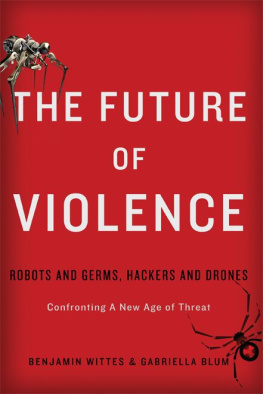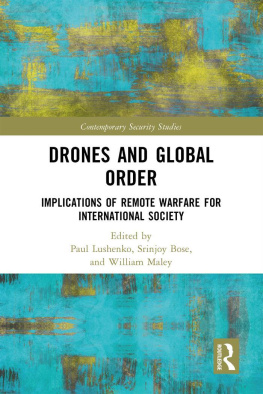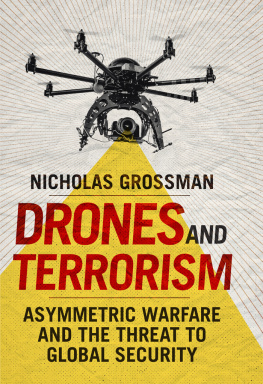

Copyright 2015 by Benjamin Wittes and Gabriella Blum
Published by Basic Books,
A Member of the Perseus Books Group
All rights reserved. Printed in the United States of America. No part of this book may be reproduced in any manner whatsoever without written permission except in the case of brief quotations embodied in critical articles and reviews. For information, address Basic Books, 250 West 57th Street, New York, NY 10107.
Books published by Basic Books are available at special discounts for bulk purchases in the United States by corporations, institutions, and other organizations. For more information, please contact the Special Markets Department at the Perseus Books Group, 2300 Chestnut Street, Suite 200, Philadelphia, PA 19103, or call (800) 810-4145, ext. 5000, or e-mail .
Book design by Cynthia Young
Library of Congress Cataloging-in-Publication Data
Wittes, Benjamin.
The future of violence : robots and germs, hackers and dronesconfronting a new age of threat / Benjamin Wittes & Gabriella Blum.
pages cm.
Includes bibliographical references and index.
ISBN 978-0-465-05670-5 (e-book) 1. National security. 2. Security, International. 3. Internal security. 4. TechnologyMoral and ethical aspects. 5. Information technologyMoral and ethical aspects. 6. Civil rights. 7. ViolencePrevention. 8. Crime prevention. I. Blum, Gabriella. II. Title.
UA10.5.W57 2015
303.601'12dc23
2014035741
10 9 8 7 6 5 4 3 2 1
For Ruth Kartun-Blum, Janet Wittes, and Robert Wittes
CONTENTS
IMAGINE FOR A MOMENT that we changed one fact about the 2001 anthrax attacks, which killed five people and sickened seventeen others in the wake of September 11, 2001. The FBIs suspect in the case, Dr. Bruce Ivinsor whoever else may have been responsible for the attackswas clearly not attempting to kill as many people as he possibly could. The anthrax-laced letters all either specifically identified their packages as carrying the bacteria or warned recipients to TAKE PENACILIN [sic] NOWwhich is kind of like putting a big sign on a bomb and cartoonishly labeling it BOMB. Moreover, using the US Postal Service to distribute the packages kept the anthrax spores in relatively contained spaces: postal-system buildings, the buildings of targeted entities, and the channels of postal distribution. Nevertheless, spore leakage caused illness and even death among some people outside the postal system.
Now imagine that the objective of the attack had been to maximize casualties and that the attacker acted accordingly. Instead of mailing labeled packages to specific targets, suppose he had created a delivery system aimed at reaching the public at large. Using a real website called DIY Drones, which describes itself as the largest community for amateur unmanned aerial vehicles [UAVs], let us say that the attacker built a robotic distribution system to spread the spores over densely packed groups of people. DIY Drones is not a site for the high-tech weekend warrior. The do-it-yourselfers it serves are hobbyists, as the sites policies make clear. This site is just about amateur and civilian use, DIY Drones declares, warning that it tolerates no discussion of military applications of UAVs and will report to authorities any discussion of UAV use that we feel is potentially illegal or intended to do harm. Still, it is not hard to imagine that our bloodthirsty anthrax attacker would find irresistible a site devoted
If this sounds far-fetched, it should not. The technology in reality is not that complicated. In fact, our hypothetical attacker may well have overinvested in automation. He could probably obtain the same effect by releasing spores from the back of a truck in a crowded downtown area or by hand at the stadium. Nor is the idea of using small drones for domestic terrorism limited to the realm of speculation. In September 2011, the FBI arrested a US citizen named Rezwan Ferdaus, as the Justice Department put it, in connection with his plot to damage or destroy the Pentagon and U.S. Capitol, using large, remote controlled aircraft filled with C-4 plastic explosives.
Had the anthrax attacks played out in one of these counterfactual fashions, no one reading this book today would doubt the proposition that it is possible for an individual to have his own personal weapons-of-mass-destruction program. Nor would anyone doubt that destructive power once reserved to states is now the potential province of individuals. Nobody today would doubt that the range of actors that statesand individualsmust consider as potential strategic threats has broadened dramatically.
To demonstrate this, let us change one fact in the already terrifying case of Luis Mijangos, an illegal immigrant in Orange County, California, who in 2011 pleaded guilty to computer hacking and wiretapping and was sentenced to six years in prison. Mijangos tricked scores of women and teenage girls into downloading malware onto their computers. In addition to using the private financial information that he stole from their computers for garden-variety credit card fraud, Mijangos, according to court documents, read victims emails and [instant messages], watched them through their webcams, and listened to them through the microphones on their computers. He also used the webcams to take surreptitious images of his victims. Moreover, he used [those] intimate images or videos of female victims he stole or captured to sextort those victims, threatening to post those images/videos on the Internet unless the victims provided more to defendant; in at least one instance he followed through on his threat
Mijangos represents the democratization of 1984 and the power to track, probe, and invade the privacy of others. These days, Little Brother can do it too. And Little Brother may well operate outside Oceania. Bad as the Mijangos case was, if we simply change Mijangoss location, it gets dramatically worse. Imagine for a moment that he had operated out of not California but Nigeria, home to a great deal of spamming and online fraud activity. In the real story, Mijangos could ultimately be stopped because FBI agents were able to visit his house, interview him, seize his computers, and mine their contentsand ultimately because they had jurisdiction to arrest him. A great many countries in the world, however, have neither the will nor the means to monitor cybercrime, prosecute offenders, or extradite suspects to the United States. Had Mijangos been in one of these countries, his case would today illustrate not merely the extreme vulnerability of individuals in a modern networked world, but also the impunity with which we can be attacked from just about anywhere on the planet and by just about anyone. Ironically, while we tend to think of government investigative powers in the networked world as Big Brotherlike threats to our privacy, the Mijangos tale also suggests how important the role of government authority can be in protecting values such as privacy in a world where lots of Little Brothers menace us from both within and outside the states in which we live.
Now, more futuristically, let us change one fact about the famous assassination of Alexander Litvinenko, a former officer of the Russian Federal Security Service, successor to the KGB. Litvinenko wrote two books in which he accused the Russian secret services of bombing Russian apartment buildings and engaging in other acts of terrorism in order to facilitate Vladimir Putins ascent to power. Facing prosecution in Russia, he fled and received political asylum in the United Kingdom. On November 1, 2006, Litvinenko suddenly fell ill and was hospitalized. He died three
Next page













